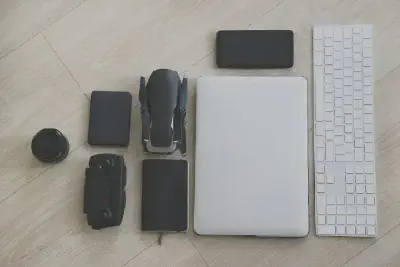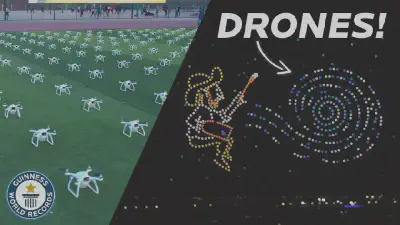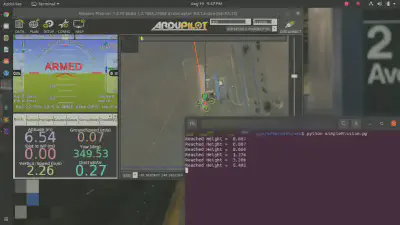Drone Programming - Is it Hard to Program a Drone?
November 30, 2021 in Aerospace, Programming by ![]() Dhulkarnayn—9 minutes
Dhulkarnayn—9 minutes
The enchanting hum of propellers, the dance of unmanned wings—drones have swiftly woven themselves into the tapestry of our modern world. Picture this: a sky adorned with 868,012 registered drones in the United States, as per the latest symphony composed by the Federal Aviation Administration (FAA) until November 2021. Among these, a staggering 339,998 are the airborne maestros of commercial applications, orchestrating a revolution that transcends the conventional realms of aviation.

Image Credits: Pixabay
But these aren’t just aerial machines; they are canvases waiting to be painted with the strokes of programming brilliance. Beyond their physical form, drones become vessels of innovation, their flight controlled not just by algorithms but by the creativity of programmers. Imagine drones seamlessly navigating the skies, not just for surveillance or military missions, but for delivering packages to your doorstep or crafting mesmerizing light shows that paint the night with luminescent strokes.
In a world where technological marvels are becoming commonplace, drones stand out not only for their sheer numbers but for the myriad possibilities they unlock. Whether soaring through the air on critical missions or performing aerial ballets, drones are becoming indispensable, and at the heart of their evolution lies the magic of programming.
In this realm of limitless skies and coded commands, we delve into the question: Is it hard to program a drone? Let’s unravel the mysteries of drone programming and discover the seamless blend of technology and creativity that propels these unmanned wonders to new heights.
Unleashing the Power of Imagination: The Art and Craft of Drone Programming
Is the realm of drone programming an elusive puzzle, shrouded in complexity? Fear not, for unraveling the secrets of commanding these airborne marvels is an adventure well within reach. In the symphony of programming languages, drones await the maestro, and the stage is set for your coding crescendo.
In straightforward terms, programming a drone is a journey far less daunting than it may seem. The key? Familiarity with the programming language embraced by the drone’s flight controller. But worry not if you’re not yet fluent in the language of code; the gateway to drone programming mastery swings open to both seasoned coders and eager novices alike.
Enter Python, the virtuoso of programming languages—a symphony of simplicity and power. As an interpreted high-level general-purpose language, Python beckons with open arms, welcoming those who seek to breathe life into their drone endeavors.
Picture this: a world where most programmable drones extend their wings in harmony with Python’s rhythmic commands. While some may argue that Python’s low-level support might lack the precision of languages like C and C++, it’s a trade-off well worth making, especially for beginners venturing into the skies of programming or those seeking seamless execution of advanced operations.
But let’s not merely scratch the surface; let’s plunge into the heart of drone programming’s artistry. Imagine orchestrating a ballet in the skies—a Drone Light Show. In this dazzling spectacle, programming takes center stage, directing drones to pirouette and glide in perfect unison through the vast expanse of airspace.

Video Credits: Guinness World Records
Behold, the spectacle unfolds! A mesmerizing 26 minutes and 19 seconds—an enchanting ballet orchestrated by unmanned aerial vehicles (UAVs). Witness the magic created by the EFYI Group (China), with the support of Tianjin University, on a crisp December day in Tianjin, China, in 2020.
In this captivating world where code and creativity collide, programming a drone becomes not just a technical feat but an artistic endeavor. As we journey deeper into the intricacies of drone programming, let your imagination take flight, and may your coding endeavors soar to new heights.
Decoding the Symphony of Drone Languages: Where Code Takes Flight
In the vast landscape of drone programming, languages become the notes that compose the symphony of unmanned flight. Let’s unravel this musical tapestry and explore the two major categories of programming languages that guide drones through the skies:
Low-Level Programming: The Silent Dance of Firmware Mastery
Venturing into the depths of drone programming, we encounter the intricate dance of low-level programming. Here, the language of choice is not always easily deciphered by the untrained eye. It’s a realm where firmware and board-level modifications take center stage, transforming drones into finely tuned instruments.
Enter C and C++, the virtuosos of the low-level world. These languages grant programmers the freedom to conduct the orchestra of memory management and firmware-level operations. While not the most human-friendly, they offer unparalleled control, making them the preferred choice for those seeking to squeeze every ounce of performance from their drones.
In this silent dance, advanced users find solace, embracing the reduced resource usage and efficient management that low-level programming provides. It’s a delicate balance, where precision meets complexity, shaping drones into instruments of technical mastery.
High-Level Programming: Python’s Melody in the Sky
Now, let’s ascend to the clouds of high-level programming, where Python takes the lead in orchestrating the general-purpose operations of drones. Unlike the cryptic codes of low-level languages, Python unveils a more user-friendly learning curve—a gateway for enthusiasts and aspiring programmers alike.
Picture Python as the maestro, guiding drones through the skies with elegance and simplicity. In this realm, you’re liberated from the intricacies of register and cache level memory operations. Why? Because the API (Application Programming Interface) takes care of the nuances, allowing you to focus solely on the grand gestures of drone control.
As you navigate the skies through high-level programming, your concerns shift from deciphering memory intricacies to orchestrating the drone’s journey—plotting waypoints, retrieving video feeds, and deciding when to track objects. It’s a realm where the language of instruction is clear, the possibilities are expansive, and the sky is not the limit but the canvas for your coding artistry.
In this symphony of drone languages, whether dancing in the subtleties of low-level intricacies or soaring with Python’s harmonious melodies, every line of code becomes a note in the grand composition of unmanned flight. So, fellow coders, pick your language, let your creativity soar, and embark on the mesmerizing journey of programming drones to new heights.
Commanding the Skies: Unleashing the Secrets of Drone Choreography
So, you’ve dipped your toes into the world of drone programming, and now the stage is set for the grand performance—programming your drone to dance across the skies. Let’s demystify the art of drone choreography and discover the tools that transform your code into soaring maneuvers.
Proprietary Programmable Drones: A Symphony of Commands
If your drone boasts proprietary programming capabilities, you hold the reins to a world of possibilities. Enter the stage with the proprietary API (Application Programming Interface) or SDK (Software Development Kit), your orchestral baton for directing the drone’s every move.
Imagine this: a canvas where high-level commands paint the sky with the graceful strokes of motor movements. The API/SDK becomes your musical sheet, with notes that guide the drone’s flight—takeoffs, landings, twists, and turns—all choreographed by the commands you script into your code.
Image Credits: Technology illustrations by Storyset
DIY Drones and Community-Supported Flight Controllers: Enter DroneKit-Python
But what if your drone is a bespoke creation or relies on community-supported flight controllers like Pixhawk or Navio? Fear not, for here comes the virtuoso, DroneKit-Python, to elevate your programming endeavors.
DroneKit-Python, the maestro of APIs, allows developers to compose Python symphonies that seamlessly communicate with vehicles over the MAVLink protocol. It’s not just an API; it’s the portal to a world where your code takes flight, where every line is a note in the melody of drone control.
Picture this: a community of DIY enthusiasts crafting their own skyward ballets. With DroneKit-Python, you’re not just coding; you’re scripting the movements of your drone, conducting it through the airspace with the finesse of a maestro leading an orchestra.
So, fellow virtuosos of the code, whether commanding a proprietary marvel or embarking on a DIY odyssey, the skies await your direction. Dive into the world of DroneKit-Python, let your creativity soar, and witness the magic as your code orchestrates a dance of drones that captivates the very heavens. The symphony of drone programming is yours to compose!
Unleash the Code: A Drone’s Ballet in Python
Now that we’ve laid the groundwork for drone programming, it’s time to step into the spotlight and witness the magic of code transforming into airborne choreography. Brace yourself for the unveiling of a Python script that dances with the skies—introducing the enigmatic simpleMission.py.
The Prelude: A Symphony of Understanding
Before we dive into the code, let’s take a moment to appreciate the symphony of knowledge orchestrated in the preceding sections. We’ve explored the languages that guide drones, the artistry of high and low-level programming, and the tools at our disposal. Now, the stage is set for our Pythonic drone to take flight.
Meet simpleMission.py: Where Code Meets Sky
1# Import Necessary Packages
2from dronekit import connect, VehicleMode,LocationGlobalRelative
3import time
4
5def basicTakeOff(altitude):
6
7 """
8 Inputs:
9 1. altitude - TakeOff Altitude
10 """
11
12 vehicle.mode = VehicleMode("GUIDED")
13 vehicle.armed = True
14 time.sleep(2)
15 vehicle.simple_takeoff(altitude)
16
17 while True:
18 print("Reached Height = ", vehicle.location.global_relative_frame.alt)
19
20 if vehicle.location.global_relative_frame.alt >= (altitude - 1.5):
21 break
22 time.sleep(1)
23
24
25# Connecting the Vehicle
26vehicle = connect('udpin:127.0.0.1:14551', baud=115200)
27
28# Takeoff the Vehicle
29takeOffAltitude = 10
30basicTakeOff(takeOffAltitude)
31print("Reached:", takeOffAltitude, " m")
32
33# Landing the Vehicle
34vehicle.mode=VehicleMode('LAND')
35print("Landing the Vehicle!!!")
36time.sleep(1)
37
38print("Exiting the Code!!!")
39time.sleep(1)Source: Link
The Grand Act: A Drone’s Ballet in Pythonic Harmony
Behold, simpleMission.py—more than a mere script, it’s a portal to the realm where code orchestrates the ballet of autonomous takeoffs and landings. With Python as its language, this script unfolds a narrative where the drone, guided by your commands, rises to the skies and gracefully descends to Earth.
As you delve into the lines of code, envision the drone taking its maiden flight, reaching heights, and performing a seamless landing. The basicTakeOff function becomes the choreographer, instructing the drone to ascend to the specified altitude before gracefully returning to the ground.
The Finale: Soaring with Your Code
Execute the script, witness the drone’s ballet, and let the symphony of simpleMission.py resonate with the skies.
python simpleMission.pyYour journey into drone programming has now evolved from theory to a tangible performance. As you exit the code, savor the satisfaction of having orchestrated a dance in the heavens, and remember—the skies are your canvas, and your code, the brush that paints the spectacle.

Video Credits: Dhulkarnayn, Elucidate Drones
Enjoy the grand finale of your code’s performance in the boundless theater of the skies!✨
Conclusion
As our drone programming adventure lands on the runway of conclusion, I’m eagerly awaiting your thoughts. Let’s keep the conversation alive in the comments—share your victories, ask questions, and be part of our coding community.
Remember, sharing is caring! If this journey sparked excitement, spread the word. Invite your friends to join the coding odyssey, and let’s see their drones take flight.
Your feedback is the wind beneath our wings. Thank you for being part of this thrilling journey. Until next time, happy coding, fellow aviators! 🚀
This post is licensed under Creative Commons Attribution-ShareAlike 4.0 International (CC BY-SA 4.0) by the author.
Please consider supporting this project!
If this article has been of help to you, and you feel generous at the moment, don’t hesitate to buy us a coffee. It's an easy, fun and direct way to show your support — any amount of coffee is highly appreciated.